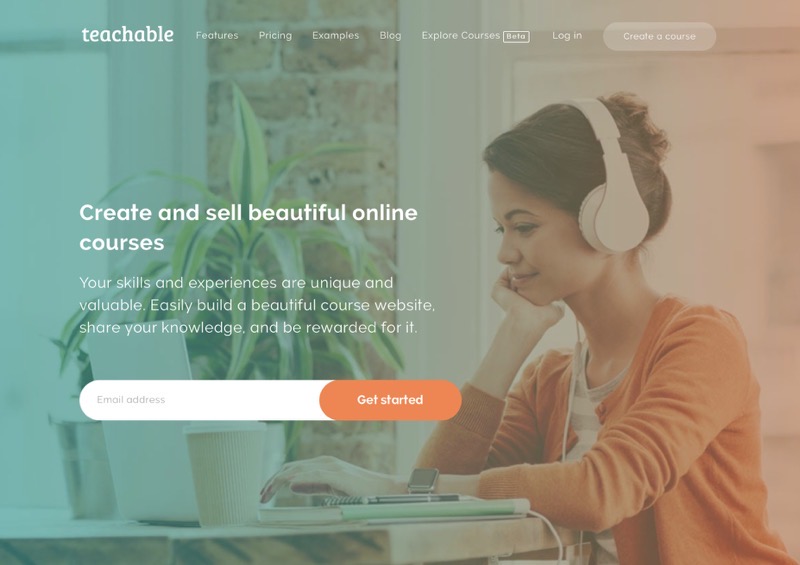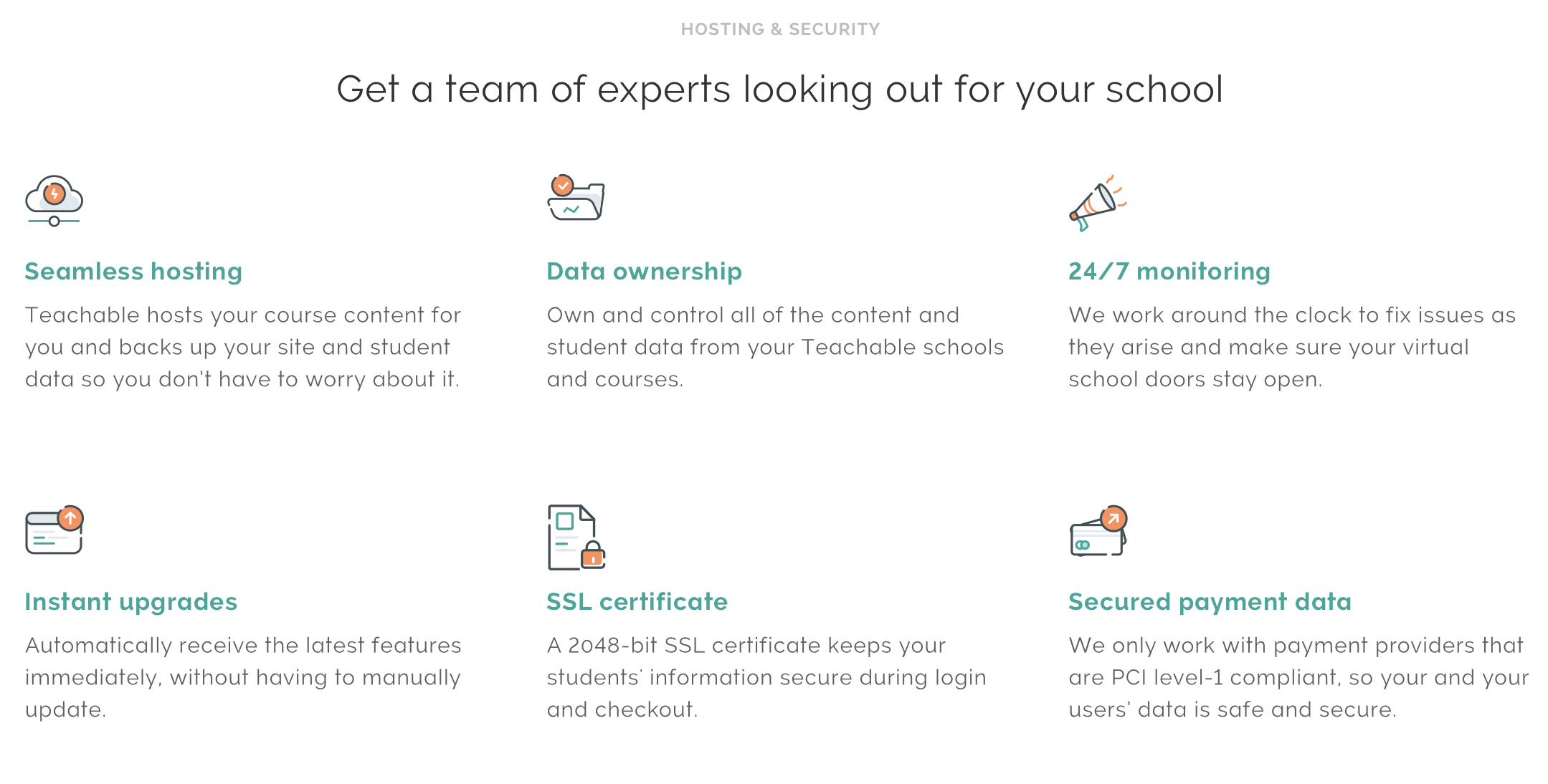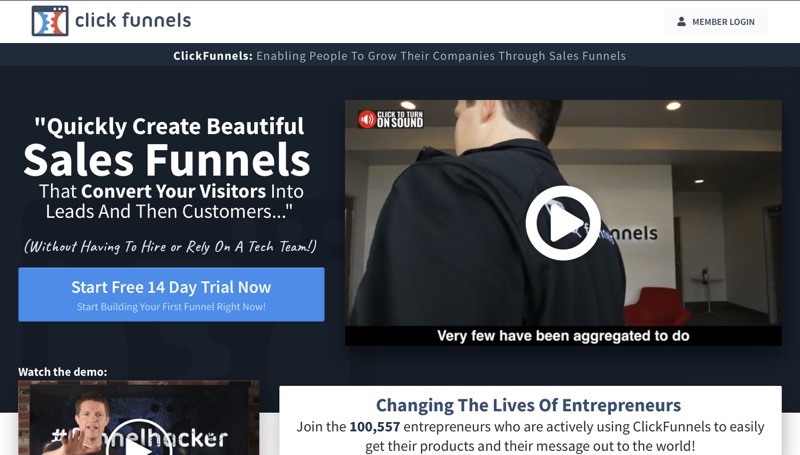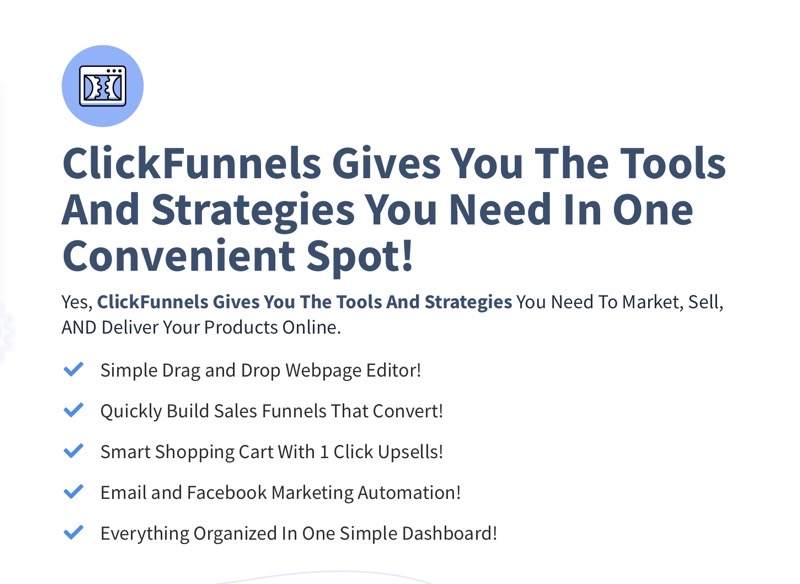Teachable and ClickFunnels. A lot of people have never said those two names in the same breath. And that’s understandable; at first blush, they don’t seem to have much in common. But you begin to see the similarities when you dig a little deeper. And where there are similarities, there will be comparisons.
Teachable and ClickFunnels are both big names in their individual industries. Teachable is one of the top learning management systems out there. ClickFunnels has somewhat cornered the market when it comes to creating sales funnels. Both are clearly very successful products in their own right.
Click Here To Try Teachable For Free

Teachable vs Clickfunnels
Though disparate in their core offerings, there is overlap in the way they can be used. If you’re a course creator on the Internet, you can use both Teachable and ClickFunnels to market and sell your courses. Both offer features to build websites and landing pages using a drag-and-drop interface. So there could be a situation where you have to choose between Teachable and ClickFunnels.
Given that that’s the case, it’s important to know which of these products is the better option. Before we get down to comparing them, let’s see what they do individually and what their core features are.
Teachable – Overview
Teachable, as mentioned earlier, is a learning management system. That’s a software that can be used to build online courses and teach students remotely. Products in this industry have become immensely popular as more educators turn to the Internet to grow their businesses. If you want to know just how popular online education has become, all you need to do is take a look at Teachable’s numbers.
There are currently over 257,000 active courses on Teachable with more than 23 million students enrolled in them. Those courses are made by 83,000 instructors who have raked in a combined 555 million dollars. Those aren’t bad numbers, aye?
Teachable trains its focus squarely on creating and selling courses. This is a product aimed at people who want to teach online and gives them all the tools needed to do that. What you want to teach doesn’t matter. It could be anything from high school physics to card tricks. As long as you have something to teach people, you can use Teachable to build a course around it and find an audience that wants to learn from you.
Teachable’s software covers every aspect of setting up and running an online school. Of course, they offer a course creator so you can create lessons and combine them into a course. You can include video, audio, quizzes and more in your courses. These multimedia tools help you keep your students engaged in different ways.
Along with the basic course creation tool, Teachable also has tools to help you manage your online school and attract new students. This is what helps you create a sustainable online teaching business. That includes things like enrollment management, community building, payment collection, sales funnels, and collaboration. Let’s take a closer look at Teachable’s features.
Click Here To Try Teachable For Free
Teachable Features
So we already know that you can use Teachable to build online courses. The offering here is simple. Users can create courses in various formats such as text, video, and audio or combine them. You can also import existing content from Dropbox, OneDrive, and Google Drive to speed up that process.
1. Teachable Website Builder
Now once you have a course ready, you’ll want to create a website so that visitors know what you’re selling. That can be done using Teachable. The software has a drag-and-drop builder using which you can create a website that talks about your online school. If you do want to play around with the website’s code you can using Teachable’s Power Editor. All websites created using Teachable are fully responsive so you can reach students on different kinds of devices.
2. Teachable Learning Tools
The primary focus for any school should be ensuring students stay engaged. Teachable provides its customers with plenty of tools to make that happen.

Quizzes are natively supported on the Teachable platform. It’s easy to put together quizzes to gauge where students are and to reinforce concepts from particular lessons.
Another important aspect of running a course is enforcing compliance. You may want students to complete certain lectures or get a certain score on a quiz before moving on. These requirements can be built into your courses.
When students do complete courses or reach certain milestones, you can hand out completion certificates on the platform. These certificates can be customized to look exactly how you want and to match your brand. Certificates are a great way to keep students encouraged and to authenticate their completing a course.
Through all of this it’s important to know what students like and dislike about your course. You can gather feedback on Teachable using in-built surveys and Google Forms. You can create student lists based on things like their completion stage and code redemption to send out targeted emails to them.
3. Teachable Marketing Tools
Teachable comes with a library of conversion-tested sales pages. Customers can pick any of these pages and customize them to create sales pages for particular courses. You can also start from scratch and build one using Teachable’s landing page builder.
This learning management system supports different kinds of payment cycles. You can sell courses with a one-time fee, subscription, bundles, and so on. You can market your courses by creating coupons on Teachable and set the expiration dates that you want.
One of the most popular growth hacking methods is affiliate programs. Teachable has its own affiliate marketing management tool. You can use this feature to on-board affiliates, set commission rates, and manage payouts.
Teachable has a number of features that can help you manage your marketing campaigns better. The conversion pixel support gives you insights into how effective your advertising efforts are. The software also comes with first and last touch attribution so you can trace where people first came across your campaign and what path they took through the sales funnel.
4. Teachable Analytics Tools
The Teachable dashboard gives you a comprehensive overview of all the key data associated with your online school. It’s easy to access data on the number of enrollments across different courses, revenue, and other such information.
Also, importantly, administrators can get analytics on how students are performing on each of their courses. So you know exactly how many students complete your courses, how many there are across different payment options, etc.
Teachable’s Zapier integration supercharges the analytics features available on the platform. You can use the integration to send particular events to other analytics tools. For example, you trigger an email every time a student forgets to renew their membership. Such measures are invaluable to your retention efforts.
Click Here To Try Teachable For Free
ClickFunnels – Overview
ClickFunnels started off as a tool to help anybody create high-converting sales funnels online. It was one of the first products to focus just on sales funnels instead of being a more generic website builder.
Now at this point some of you are probably wondering what the difference between a website and a sales page is. Websites, after all, sell people on the product you’re offering them.
The difference is a subtle one. Websites are made up of multiple pages that talk about a host of different aspects of your business. Some of these may be dedicated to specific products. Others may talk about the history of your company or hand out your contact information.
A sales funnel is a lot more focused. The goal of a sales funnel, as you’ve probably guessed, is to sell a product or service. There’s no extraneous information on this page. There aren’t too many links that lead to other pages or your social media handles. The goal is to guide visitors through a process that starts at them learning about the product and culminates in them purchasing it. ClickFunnels’ goal is to make creating these sales pages a breeze.
ClickFunnels was founded by Russell Brunson and Todd Dickerson. The company was born in 2014 when the duo realized that it took too much work and guesswork to put together sales pages online. So they built a tool that would make that process quicker and more scientific.

ClickFunnels Features
There are three goals that ClickFunnels focuses on with its sales pages. Those are generating leads, generating sales, and getting sign-ups for events.
When you start building a sales funnel with ClickFunnels, you have to choose from one of those goals. Once you choose a goal, the software will automatically create the framework required to achieve.
So say, for example, you want to generate leads for a service business you run. You would choose lead generation as your goal on ClickFunnels. For this particular goal, the software helps you create two different kinds of pages. The first is a page to capture just email addresses to build an email list. The other is a more detailed form-based page that gathers information such as visitors’ phone number, location, and anything else you may need.
1. ClickFunnels Editor
ClickFunnels Editor is the name given to its drag-and-drop page builder. This isn’t your average visual website builder. This editor has a laser focus on building sales pages and there are several features that cater to that goal.
ClickFunnels Editor starts you off with templates designed for specific purposes. That includes pre-designed pages for opt-in pages, sales pages, upsell pages, order forms, webinar pages, and even ones to create membership areas on your website. These aren’t your run-of-the-mill designs. They’ve been tested extensively to ensure a high rate of conversion.
Now it comes time to edit these pages. This is where ClickFunnels has an ingenious way to guide what you do: color-coded blocks. There are different colors to indicate rows, columns, elements and sections. The ClickFunnels Editor shows users exactly how these elements interact with each other and what kind of content should go into each of them. This feature makes it extremely simple to edit a template without violating the laws of building good sales funnels.
2. ClickFunnels Follow-up Funnels
As much as you try, a sales page will not convert all the visitors who show up to your web page. Some of them may be interested in the product but choose not to make a purchase at that time. You don’t want to give up on these folks as soon as they leave your sales page. Instead, you can use follow-up funnels to continue to pursue your audience with targeted messages.
The genius behind the follow-up funnels in ClickFunnels is the Smart Lists feature. This lets you automatically group email subscribers based on specific actions that they’ve taken. So you can have email lists based on where visitors entered the funnel, buying history, and other actions that they’ve taken on your sales page.
Once you have the list set up, it’s easy to hit them with targeted messages. You can send out emails, text notifications, and broadcast messages to people in particular lists. The real power behind this is that these lists are created based on visitors’ behaviors.
So say you have a group of people who went to your order page but left without making a purchase. With ClickFunnels you can automatically create an email list with these visitors in them. Then you can send out an email encouraging them to complete the purchase, requesting feedback on why they left without making the purchase, etc.

3. ClickFunnels Backpack
BackPack is ClickFunnels’ affiliate management feature. Users can build their commission-only affiliate program using the software.
ClickFunnels uses a feature called Sticky Cookies to further incentivize affiliates. Here’s how it works. Say someone arrives on your website using a particular Affiliate ID. Now the affiliate partner who has that ID will be paid their share for that referral. But along with that, they will also get a cut on other purchases that that customer makes on that website. Since affiliates have a greater earning potential because of Sticky Cookies, they are more likely to promote your product.
Backpack also lets you build two-tiered affiliate programs. So affiliates can bring on board other affiliates and get a small cut on their commission. With this feature you can build out your affiliate program without individually hiring each affiliate partner.
So that was an in-depth look at what Teachable and ClickFunnels offer. Let’s now compare the two and see how they do.
Teachable vs ClickFunnels – Course Builder
Now everybody knows that ClickFunnels isn’t course building software. Why then would we compare these two products on this point?
That’s because although ClickFunnels isn’t a learning management system, you can use it to build a membership site. Some online educators may be tempted to use ClickFunnels to sell memberships to their courses. So in that sense, Teachable and ClickFunnels may be in competition with each other.
Although you can use ClickFunnels to build a membership website, you probably shouldn’t for your online course. There are many reasons for this. ClickFunnels doesn’t let you track user progress; users can’t manage their own subscriptions and payment options; and the software doesn’t have in-built support for quizzes, certificates and so on. These are all features that you want from a course builder.
Teachable, on the other hand, offers all of these features and more. It is exactly what you want if you sell courses or videos online. Not only does the software let you build your courses, it also helps you manage your school and grow your audience.
So when we look at course creation, Teachable is the obvious winner.
Click Here To Try Teachable For Free
Teachable vs ClickFunnels – Marketing Features
Both Teachable and ClickFunnels can be connected to Zapier. Because of that, you can integrate these softwares with any number of marketing tools. That includes email marketing software, analytics tools, and business intelligence software.
ClickFunnels is a tool that’s meant to build a very specific kind of marketing vehicle: sales landing pages. And this it does very well. There aren’t too many products out there that do better in terms of template-based marketing funnels and sales tools.
That said, Teachable comes with its own set of marketing features. The conversion pixel support is a great way to understand whether your advertising efforts are fruitful. Another important marketing tool is the emails and notifications you can send out to students based on their behaviors. It’s a powerful way to keep your audience engaged and ensure high completion rates.
Click Here To Try Teachable For Free
Teachable vs ClickFunnels Pricing
ClickFunnels starts at $97 per month. For that price you can create 20 funnels and 100 sub-pages inside individual funnels. ClickFunnels Platinum costs $297 per month and lets you build unlimited funnels and sub-pages. It also gives you access to the follow-up funnels feature and priority support.
Then there’s the $1,497 per month package called ClickFunnels Collective. With this you can connect as many as 27 gateways and connect 27 domains. This package also gives you access to VIP phone support.
Now let’s talk about Teachable’s pricing model. The product starts at just $39 per months for the Basic plan. There’s a 5% transaction fee for users on this plan. It lets you build unlimited courses and enroll unlimited students.
For $119 per month you can go up to the Professional plan, which frees you of transaction fees. It also comes with advanced reports, course compliance, and an unbranded website. Teachable’s Business package costs $299 per month. 20-admin users, priority support, bulk student enrollment, and advanced theme customization are some of the benefits of this package.
It’s clear that Teachable is significantly more economical than ClickFunnels. At just $39 per month, the barrier of entry is low and gives you the ability to build unlimited courses with an unlimited number of students.
Click Here To Try Teachable For Free
Clickfunnels vs Teachable Reddit
What Reddit has to say about Teachable:
u/drewches: I have a client who hosts all of their courses on Teachable. I think that Teachable is a great platform since it handles a lot of the back end of things for you so you can focus on creating content.
u/connectsnk – “A good membership option is to opt for a fully managed online platform like Teachable”.
u/bigoldfeet – “Teachable is a platform for creating an online platform, but you can add in features to give your teachable site a community aspect, effectively making it a membership website.”.
What do Redditors have to say about ClickFunnels:
u/tenantreport – “ClickFunnels is worth the investment if you’re planning to build funnels and send traffic through them for your business. The first funnel you should build is the lead generation funnel. Here you offer a piece of free content in exchange for someone’s email”.
u/bootstrapspecialist – “I’ve used ClickFunnels for many years and find it an extremely valuable tool”.
u/finous – “ClickFunnels is pretty straightforward to set up, just like legos. I have had some success using it with Facebook ads”.
Teachable vs ClickFunnels – Final Thoughts
There is a lot to like about both Teachable and ClickFunnels. The former is a complete learning management system while the latter focuses just on sales funnels.
If you’re in the education business online, then the choice is obvious. Teachable is the product that will let you create beautiful courses that students anywhere can access. Although not a marketing tool like ClickFunnels, it offers plenty of marketing features. In addition to all that, it’s more economical.
So for online educators, Teachable is the way to go.
Leave a Reply